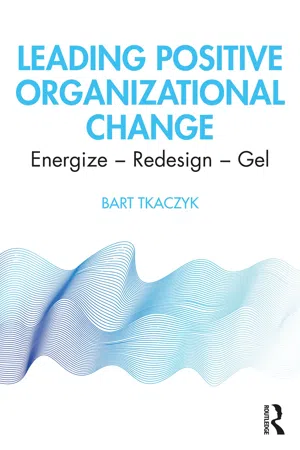
- 168 pages
- English
- ePUB (mobile friendly)
- Available on iOS & Android
About This Book
Although many organizations see the need to transform and to reinvent themselves, for far too many leaders, "change" and "failure" are virtual synonyms. In fact, most organizational change efforts fail. But that needn't be the case, and help is at hand. Leading Positive Organizational Change, an alternative way to think about organizational change and development, is a strategic, learnable discipline that can re-energize and re-imagine your enterprise, and release the potential for change – delivering a positive, creative future and breakthrough bottom-line results.
Written by an award-winning expert in positive organization development and change leadership, this book provides executives, change leaders, and change leadership teams with a step-by-step guide for collaboratively crafting and executing a change strategy that aligns with organizational objectives so as to fuel their future. With a strong science-backed and field-tested "how to" approach, and with a radical focus on organizational positivity, super-flexibility and renewal, collective design thinking and applied imagination, this highly practical book features:
-
- A ToolBox of 30 powerful, imaginative (and time-saving!) tools for you to use in practicing leading positive organizational change and carrying through your change program – with example templates and worksheets, concise notes and ideas from numerous complex global projects.
- Lead-ins to each chapter that are a fundamental feature of the book, representing a springboard to a chapter and serving the purpose of awakening interest in the topic.
- Dialogic Reflection for Professional Team Development, at the start of each chapter, that enables you (and your team as a whole) to reflect on and discuss some thought-provoking questions, linking to the chapter and helping to contextualize your learning.
- Industry Snapshots that explore current issues and trends in one of the fastest-growing professions and industries – coaching and consulting.
- Windows on Practice that demonstrate how issues are applied in real-life business situations, offering a range of interesting topical illustrations of positive change leadership in practice, relating the core concepts of the book to real-world settings.
- Summary Propositions, at the end of each chapter, that recap and reinforce the key takeaways from the chapter.
- References to help you take your learning and development further.
Tkaczyk's engaging, reflective, task-based book equips the change leader and leadership teams with the skills needed to navigate chaos and the unexpected, to renew your business and create winning change. This action-based workbook can be used in a variety of business settings, among others, executive leadership team meetings, organization development and change consulting, design-led strategy retreats, human resource development consultancy, executive 1: 1 and team coaching, leadership boot camps, design thinking workshops and sprints, innovation labs, and executive education and MBA courses – as a handy additional text in either an organization development and change or human resource management class. It can also be used in a flexible strategic transformation program – with the flow of the change execution process mapped within the context of a specific change initiative.
Frequently asked questions
Part I
Understanding the practice of leading positive organizational change
1 An alternative strategy for leading positive organizational change
Dialogic reflection for professional team development
- Why do so many change initiatives fail so often?
- If a major change program had to be implemented in your enterprise, what do you think would be the major barriers that would stand in its way, and what can you and your organization do to remove (some of) those barriers?
- Do you know some popular theoretical frameworks that can help guide the change process and management effectively?
- What are continuously change-ready and learning-ready enterprises very good at doing?
- “Change should be planned and dictated from the top. When the change is announced, frontline employees will just go along and deliver it.” Do you agree or disagree with this statement?
- Now, reflect upon your own approach to leading change so as to deliver a creative future. How would you describe your role as a change leader (e.g., as a change architect, catalyst, challenger, team coach, connector, designer, director, dreamer, positive energizer, explorer, futurist, disruptive innovator, insider expert, interpreter, mentor, monitor, navigator, negotiator, networker, nurturer, socializer, storyteller, cultural steward, teacher, digital transformer, or a trusted advisor)?If you want something new, you have to stop doing something old.
Change is fierce: important lessons from the field
Table of contents
- Cover
- Half Title
- Title Page
- Copyright Page
- Dedication
- Table of Contents
- Acknowledgments
- List of abbreviations
- Introduction
- Part I Understanding the practice of leading positive organizational change
- Part II ToolBox: tools and templates for the practice of leading positive organizational change
- An open invitation: let’s engage
- About the author
- Index